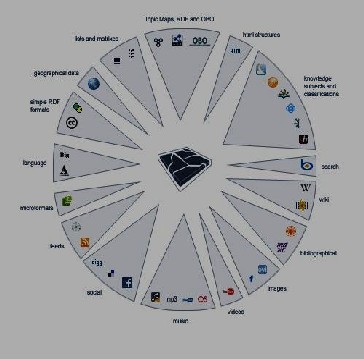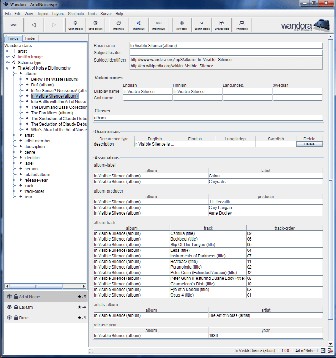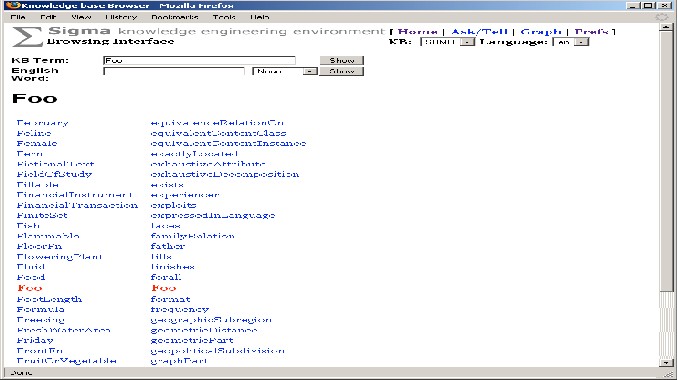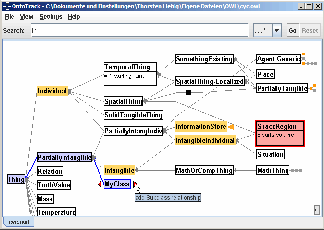International Journal of Scientific & Engineering Research, Volume 3, Issue 10, October-2012 1
ISSN 2229-5518
A Survey on Ontology Tools
Ms.V.Vidya, Mrs.S.C.Punitha
Abstract--Ontology provides a shared vocabulary, which can be used to model a domain, that is, the type of objects and/or concepts that exist, and their properties and relations. When starting out on an ontology project, the first and reasonable reaction is to find a suitable ontology software tool. Our main concern must include the provided capabilities like ontology versioning (the project development often involves various ontologies – external as well as newly in-house developed), mapping and linking, comparing, merging, reconciling and validating, converting them into other forms (such as XML Schemas, database schemas, and others). This paper presents a survey on ontology tools and the material is focused on features that these tools might expose.
Index Terms— comprehensive ontology tools, editing tools, ontology, OntoTrack, Sigma, SUMO, Wandora.
—————————— ——————————
1 INTRODUCTION
ntologies provides in depth properties and
classes such as inverses, unambiguous properties, unique properties, lists, restrictions, cardinalities, pair wise disjoint lists, data types, and so on. Ontologies are often able to provide an objective specification of domain information by representing a consensual agreement on the concepts and relations that characterize the manner knowledge in that domain is expressed. This specification can be the first step in building semantically-aware information systems to support diverse
enterprise, government, and personal activities.

Ms.V.Vidya, M.Phil Scholar, PSGR Krishnammal College for
Women, Coimbatore, India vidyavenkat19@gmail.com
Mrs.S.C Punitha, Head of the Department, Computer Science, PSGR Krishnammal College for Women, Coimbatore, India. saipunith@yahoo.com
Ontologies may vary not only in their content, but also in their structure and implementation. Among the features and requirements that certain ontology might compel, we can enumerate [2, 3]:
– Level of description – building an ontology, we might reveal different aspects to different practitioners. Describing knowledge starts from simple lexicons or controlled vocabularies, to categorically organized thesauri or taxonomies where terms are related hierarchically and can be given distinguishing properties that can define new concepts and where concepts have named relationships with other concepts;
– Conceptual scope – ontologies can be used in different domains describing specific information (e.g., medicine, aeronautics, etc.); also, there are upper level ontologies, such as Suggested Upper Merged Ontology (SUMO) [5], describing the basic concepts and relationships invoked when information about any domain is expressed in natural language;
– Instantiation – this aspect concerns populating the ontology with instances or
IJSER © 2012 http://www.ijser.org
International Journal of Scientific & Engineering Research, Volume 3, Issue 10, October-2012 2
ISSN 2229-5518
individuals that manifest that
terminological definition. This extension can be separated in implementation from the ontology and maintained as a knowledge base (ABox component in terms of description logic [1]);
– Specification language – a number of possible languages can be used, including general logic programming languages like Prolog. More common, however, are languages that have evolved specifically to support ontology construction, for example OKBC (Open Knowledge Base Connectivity) model and KIF (Knowledge
Inference Format). These proposals have become
the bases of other ontology languages. There are also several languages based on a form of logic thought to be especially computable known as description logics [1]. A standardized language is Web Ontology Language (OWL) – details in [2], [3] and [5]. When comparing ontology languages, what is given up for computability and simplicity is usually language expressiveness. A language needs only be as rich and expressive as is necessary to represent the fine distinction of knowledge that the ontology’s purpose and its developers demand.
2 Comprehensive Ontology Tools
2.1 Wandora
Wandora is a general purpose [6] information extraction, management and publishing application based on Topic Maps and Java. Wandora has graphical user interface, layered and merging information model, multiple visualization models, huge collection of information extraction, import and export options, embedded HTTP server with several output modules and open plug-in architecture.
Wandora is a FOSS application with GNU GPL(General Public License (GPL) license. Wandora is well suited for constructing ontologies and information mashups. Wandora is well suited to OBO visualizations and knowledge mashups combining OBO, RDF(S), and Topic Map resources.
The following are most fundamental features of Wandora application.
Desktop application
Fast and reliable
Requires Java 1.6
Graphical user interface
Topic map browser
Graph visualization of a topic map
Treemap visualization of topics
Build your own interactive visualizations using embedded Processing language.
Layered storage of knowledge
Construct the knowledge using several different layers, each containing only part of the knowledge
You can view only parts of data and hide parts that don't interest you
Automatic merging of different and even distributed data sources
Protect some parts of topic map by allowing only read access
Use nested layer stacks to create tree like layer structures
Several data storage options
Memory based topic map for very fast processing of relatively small topic maps
Database storage makes it possible to use topic maps of virtually unlimited size.
Figure.1 shows wandora is capable of extracting and converting a wide range of open data feeds to topic map format.
Figure.2 shows the panel that views all information related to the topic, and allows the user to modify topic's internal structures such as base name, subject locator, and variant names.
IJSER © 2012 http://www.ijser.org
International Journal of Scientific & Engineering Research, Volume 3, Issue 10, October-2012 3
ISSN 2229-5518

F[gure.1 Wandora, tool to extract o open data feeds
In our example the topic is named In Visible Silence (album). Left bottom corner views topic map layers in current project. Project has three topic map layers, namely Art of Noise, Last.fm, and Base. Current topic, topic's layer distribution, and current layer are viewed in bottom right corner of the Wandora window. Above topic map layers, locates a topic tree, and a finder. Topic tree views your topics arranged along topic relations such as subclass-superclass and class-instance. Sometimes your topic doesn't contain any relations and you have to use free text search, a finder, to locate the topic.
IJSER © 2012 http://www.ijser.org
International Journal of Scientific & Engineering Research, Volume 3, Issue 10, October-2012 4
ISSN 2229-5518
Figure.2 Traditional topic panel

2.2 Sigma
Sigma is open source knowledge engineering environment [7] that includes ontology mapping, theorem proving, and language generation in multiple languages, browsing, OWL read/write, and analysis. It includes the Suggested Upper Merged Ontology (SUMO), a comprehensive formal ontology. Sigma includes a number of useful features for knowledge engineering work,
IJSER © 2012 http://www.ijser.org
International Journal of Scientific & Engineering Research, Volume 3, Issue 10, October-2012 5
ISSN 2229-5518
including term and hierarchy browsing, the ability
to load different files of logical theories, a full first order inference capability with structured proof results, a natural language paraphrase capability for logical axioms, support for displaying mappings to the WordNet lexicon and a number of knowledge base diagnostics. Sigma has served two main purposes. It is a practical tool that has supported the development of the SUMO. It is also a toolkit and testbed that is used to support experiments in ontology application and logical reasoning. Sigma has co-evolved with SUMO with each becoming more sophisticated and extensive as they progressed. The regular open source release of both products has and will continue to form a unique resource for academic and commercial researchers and practitioners engaged in ontology, natural language understanding and formal reasoning.
The following are most fundamental features of
Sigma application
Mappings to all of WordNet
Language generation templates for Hindi, Chinese, Italian, German, Czech and English
Tool support for browsing and editing
Largest free, formal ontology available, with ~25,000 terms and ~80,000 axioms
when all domain ontologies are combined.
These consist of SUMO [5] itself, the MId- Level Ontology (MILO), and ontologies of communications, countries and regions
,distributedcomputing, economy, finance, automobiles and engineering
components, geography, government, lan guage taxonomy, media, Military (general, devices, processes, people), Nort
h American Industrial Classification System, people, physical elements, transnational
issues, transportation, viruses, world
airports A-K, world airports L-Z, weapons of mass destruction. See also a large amount of instance content from DBPedia about people and the YAGO, project which includes millions of facts from Wikipedia merged with SUMO, and an initial merge of the Mondial geographical data with SUMO. The Open Biomedical Ontologies are being mapped to SUMO. Additional ontologies of terrorism are available on request.
Richly axiomatized, not just taxonomy. All terms are formally defined. Meanings are not dependent on a particular inference implementation. An inference and ontology management system however is provided. An additional system that supports visual editing, and does a better job of displaying the ontologies, especially in non-Western languages is the KSMSA system.
Figure.3 shows The Browsing Interface displaying the terms closest, alphabetically, to an unknown term
IJSER © 2012 http://www.ijser.org
International Journal of Scientific & Engineering Research, Volume 3, Issue 10, October-2012 6
ISSN 2229-5518

Figure.3 shows The Browsing Interface displaying the terms closest, alphabetically, to an unknown term
3 Ontology Editing Tool
3.1 OntoTrack
OntoTrack is a new browsing and editing “in-one-
view” ontology authoring tool that combines a hierarchical graphical layout and instant reasoning feedback for (the most rational fraction of) OWL Lite. OntoTrack provides an animated and zoom able view with context sensitive features like click- able miniature branches or selective detail views together with drag-and-drop editing. Each editing step is instantly synchronized with an external reasoner in order to provide appropriate graphical feedback about relevant modeling consequences. The most recent feature of OntoTrack is an on demand textual explanation for subsumption and equivalence between or unsatisfiability of classes.. ONTOTRACK implements a novel approach using one integrated view for browsing and editing optimized for navigation and manipulation of large OWL Lite ontologies. The system is based on SpaceTree and implemented in Java2D.
The following are most fundamental features [8] of
OntoTrack application
provides a sophisticated ontology layout with animated expansion and de- expansion of class descendants, zooming, panning
uses elaborated layout techniques like branches or selective detail views
At the same time it allows for quite a number of editing features like mouse- over anchor buttons, graphical selections or detail view editing without switching into a special editing layout.
In addition, every single editing step is synchronized with the external RACER reasoner in order to
IJSER © 2012 http://www.ijser.org
International Journal of Scientific & Engineering Research, Volume 3, Issue 10, October-2012 7
ISSN 2229-5518
provide instant feedback about relevant
modeling consequences.
Other features cover instant search highlighting or an overlay representation of classes and properties
Since it is a pure Java application it runs on almost all Java-enabled platforms.
Figure.4 shows an interface of OntoTrack.

Figure.4 An interface of OntoTrack
4 Survey Results
At the end of our study, we noticed that every tool has some nice, but particular, features and we consider that choosing the right tool is related with the type of user (beginner/expert), with the type of ontology (small/large) and, not least, with the features that an developer might require (for example, graph view, quick development, using certain data formats, etc.).
Keeping these observations in mind, our opinion is that for “home use” (individual or academic study) the best suited tools are OntoTrack and Sigma, while – if we need to develop large ontologies with complex architectures – best solution is provided by Wandora, a tool for professional designers.
5 Conclusion
In this paper, we had drawn several features
concerning a survey on ontology tools. The tested
tools have different characteristics regarding ontology modeling and thus different features and perceptions. Some of them are intended for simple ontology development, others are complex pieces of software that are capable of general-purpose ontology building regardless of content focus.
We assume our survey can be important for all practitioners from the domain of Semantic Web technologies, as well for the interested specialists belonging to knowledge management, artificial intelligence, and computational linguistics areas. Designing accurate ontologies is a difficult and time-consuming task. Thus, a good developing tool helps to amortize this effort.
Further directions of interest will focused on a broader range of ontology editing tools (such as Altova SemanticWorks, Lexaurus Editor not covered by the actual survey) and Semantic Web frameworks, especially in the case of knowledge querying and rules modeling.
Also, we intend to develop more complex test ontologies to be used in the future versions of the survey.
ACKNOWLEDGMENT
This research work is carried out with valuable support by PSGR Krishnammal College for Women, Coimbatore, India.
REFERENCES
[1] F. Baader et al. (eds.), The Description Logic Handbook, Cambridge University Press, 2003.
[2] S. Buraga, XML Technologies (in Romanian), Polirom,
2006.
[3] M. Daconta, L. Obrst, K. Smith, The Semantic Web, Wiley Publishing, 2003
[4] M. Smith et al. (eds.), OWL Web Ontology Language Guide, W3C Recommendation, Boston, 2004: http://www.w3.org/TR/owl-guide/
[5] A. Pease, „Formal Representation of Concepts: The
Suggested Upper Merged Ontology and its Use in Linguistics”. In A. Schalley, D. Zaefferer (eds.), Ontoloinguistics, 2005.
[6] http://www.wandora.org
[7] http://sigmakee.sourceforge.net/
[8]OntoTrack”A New Ontology Authoring Approach”
IJSER © 2012 http://www.ijser.org
International Journal of Scientific & Engineering Research, Volume 3, Issue 10, Octo ber-2012 8
ISSN 2229-5518
Thorsten Liebig and Olaf N oppens,University of Ulm.
IJSER © 2012
http://WWW.IIS9COrq



